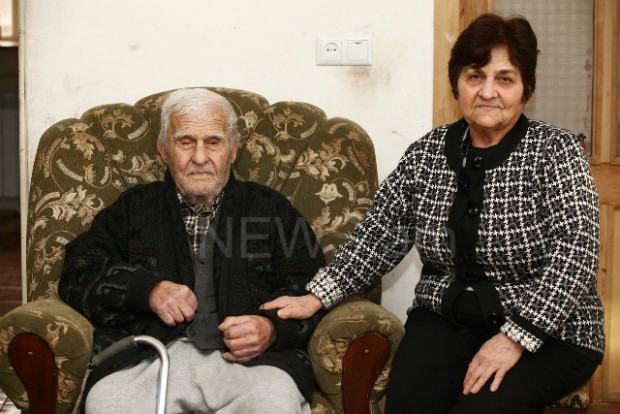
Armenian News-NEWS.am continues presenting accounts within the framework of the Survivors project, which is devoted to the Armenian Genocide that took place in the Ottoman Empire from 1915 to 1923.
“Survivors” is the stories of ordinary Armenian people who lost their childhood and homeland.
“Survivors” is one hundred years of recollections and pain, and one hundred years of expecting reparation.
“Survivors” is a diminishing group of people who will not lose their hope for the acknowledgement of their pain.
“Survivors” is 106-year-old Khachik Papisyan
Walking along the streets of quite Ptghunk village, we reach a white trailer. Abandoned and fast shut, it stands on the curved road waiting for its owner. The snow near it has melted down, and last-year’s green grass has showed up from the watery black dirt (PHOTOS).
“This is my Dad’s trailer. He used to keep beehives inside,” Araksya says on noticing our interests and leads us to the house behind it.
Cautiously crossing the threshold as if fearing to disturb someone’s rest, we follow her, watching the house decoration.
Wooden furniture, ancient delicate chandeliers, ceilings decorated with colored patterns: the house was built with love for a large family, but it’s empty today.
“The albums should be here,” Araksya says, inviting us to the living room.
We see several chairs there covered with red material, as well as a round table with white tablecloth. Several albums and a high cutglass vase with decorative flowers rest on it.
We notice the photo of a beautiful silver-haired woman in the half-empty closet by the wall. In several seconds Araksya will say that this is the mistress, her mother Gohar Gyozalyan.
Khachik Papisyan was born on 13 September 1910 in Kebusie village located at the foot of Musa Dagh. He was the fourth child and the only son in the family of Hakob and Marie. His elder sisters – Azatuhi and Iskuhi – were twins, and were followed by Makruhi. Like the majority of fellow-villagers, Hakob was engaged in farming and cattle breeding, while Marie looked after the house and brought up the children.
“Grandma Marie said Dad was a handsome man. Tall and well-built, he was a desirable groom for all the brides in the district,” Gohar says.
In 1939, due to the rise of taxes and strengthening of oppressions from the Turkish authorities, Hakob Papisyan gathered his family and headed for Anjar town in Lebanon. Exactly there Khachik got to know Gohar, whose parents were also from Musa Dagh, and they married in a year.
In 1942, daughter Marie was born to the young parents, being followed by Araksya after 4 years.
“Grandpa Hakob missed his native village very much, but he never lost his hope to return there once. However, having lived in Anjar for 8 years, he perhaps understood that nothing would change, and thus together with Dad they decided to move to Eastern Armenia. In 1947, the Papisyans temporarily moved to Etchmiadzin, and then to Ptghunk, where they built a house and started with a clean sheet, hiding the pain and craving deep in their hearts,” she says.
“It’s easy to speak now, but we are sometimes upset when we lose something important to us. And imagine a man, who had to leave his home, his vineyard and the graves of his fathers and who lost the possibility to return…”, Araksya says bitterly, going through the photos.
In 1949, Hakob Papisyan died. Marie outlived her husband by 26 years and died in 1975.
Gohar and Khachik had three mote daughters – Anna, Karine and Arpi – and a son. The latter was called in honor of Grandpa Hakob.
Leaving the home of the Papisyans, we headed for Arkasya’s house.
“Now Dad stays at my place, but he quarrels every day and wants his house,” she smiles.
When we entered, Grandpa Khachik was sitting in the armchair. As if waking up from his thoughts, he stood up and introduced himself loudly:
“Papisyan Khachik!”
He uttered no more.
In the 1990s, Araksya continues, her parents left for the U.S. together with Hakob.
The reason for such a far trip was Hakob’s health. Living in Los Angeles for 7 years, Khachik and Marie returned to Ptghunk.
“Mum had it bad. She wanted to spend her last days in Armenia, and Dad supported her decision,” Araksya says.
In her words, Khachik didn’t leave his wife’s bed, holding her hand till the very last minute.
Gohar died in 1997.
“After Mum’s death, Dad greatly lost heart,” Araksya notes, looking at her father’s side.
He refused to move to Hakob, who is in U.S.
“I am where my wife is,” he said, responding to the subsequent persuasions.
Khachik takes with him the purple scarf left after his wife wherever he goes.
“Mum sewed it herself,” Araksya says.
Khachik is the only family member alive today out of a once large family of the Papisyans who left Kebusie.
He is the grandfather of 17 grandchildren and 26 great-grandchildren. The oldest of them – Hakob’s son – was named after him as a sign of continuing the history of the Papisyan family.

































